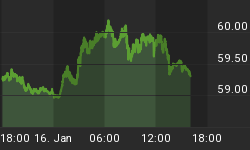Let's say the US economy goes into a deeper than expected slide and gets slammed with a nasty recession, S&P 500 profits shrivel up, and banks get hit with hundreds of billions in losses from sub-prime debt. The combined effects of the housing slump, the credit crunch, a spike in mortgage foreclosures, and crude oil bumping against $100 /barrel, appears to have sharply slowed US economic growth in the final months of 2007, and raising the odds of a recession in the first half of 2008.

The closely watched ISM factory index for December slumped to 47.7, the lowest since April 2003. A reading below 50 indicates a contraction of activity. The ISM's new orders measure fell to 45.7 from 52.6, and the employment index was below 50 for a second month. The ISM factory report added to recession fears, and crude oil's brush with $100 a barrel knocked the Dow Jones industrial average down 1.7% towards the 13,000 level, on the first day of trading in 2008, a bearish omen.
On average, the S&P 500 index lost 26% of its value, during the past 11 recessions since 1945. Recessions usually occur every 5.5 years, and the last recession was in 2002. What then for the roughly 80 million US stock market operators? Does a US economic recession translate into a weaker stock market? Can the US Treasury's "Plunge Protection Team" (PPT) put a safety net under the stock market with government intervention and massive injections of cash from the Bernanke Fed?

Because of America's influence on the global stock markets, recessions have also led to an average 23% loss in the MSCI-World Index. There are few places to hide during recessions, with all 10 sectors of the S&P 500 posting declines during recession periods. The Dow Jones Industrials, an influential stock market barometer in the world, appears to be building a bearish "Head & Shoulders" pattern, if left to its own natural devices, and free of government and Fed intervention.
But Henry Paulson has vowed to stay on at the helm of the PPT until the dying days of the Bush administration, the most interventionist White House in the affairs of the US stock market in recent memory. The PPT will fight tooth and nail to keep the DJI afloat at all costs, making life difficult for short sellers. President Bush underscored the Fed's job in navigating the economic risks on Jan 3rd. "I do have all the confidence in Chairman Ben Bernanke's ability to analyze the situation. I know he's paying very close attention to it. His response will be independent from the White House."
That's hogwash, Bernanke is a political appointee of President Bush, and will follow orders from the White House. Questions are not if the Fed will cut rates again to ease the plight of sub-prime borrowers, but by how much on January 30th. Fed funds futures show a 60% chance that the Fed could cut its benchmark lending rate by 50 basis points to 3.75%, in a state of panic.

Yet Fed rate cuts could unleash the most explosive money supply growth and hyper-inflation that the US economy has seen in decades, and weaken the value of the US$. Hyper-inflation and sharply higher oil prices can increase input costs to manufacturers, and squeeze the pocketbooks of consumers, wrecking havoc on the stability of the US economy. By the end of 2008, the DJI to Gold ratio might tumble towards 10 oz's of gold, down from 15.2 oz's today, completely wiping out the Greenspan miracle from 1996-2000.
To stay on top of volatile markets, subscribe to the Global Money Trends newsletter today, for insightful analysis and predictions for the (1) top stock markets around the world, (2) Commodities such as crude oil, copper, gold, silver, and related gold mining and oil company indexes (3) Foreign currencies (4) Libor interest rates, global bond markets and central bank monetary policies, and (5) Central banker "Jawboning" and Intervention techniques that move markets.
GMT filters important news and information into (1) bullet-point, easy to understand analysis, (2) featuring "Inter-Market Technical Analysis" that visually displays the dynamic inter-relationships between foreign currencies, commodities, interest rates and the stock markets from a dozen key countries around the world. Also included are (3) charts of key economic statistics of foreign countries that move markets.
Subscribers can also listen to bi-weekly Audio Broadcasts, with the latest news on global markets, and view our updated model portfolio for Q'1, 2008. To order a subscription to Global Money Trends, click on the hyperlink http://www.sirchartsalot.com/newsletters.php or call toll free to order, Sunday thru Thursday, 8 am to 9 pm EST, and on Friday 8 am to 5 pm, at 866-553-1007. Outside the US call 561-367-1007.
















